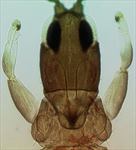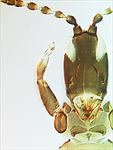
Wingless female

Antenna

Head & pronotum

Head, pronotum & fore legs

Prosternites & eyes

Metanotum & pelta

Fore tarsus & tibia

Abdominal tergite

Abdominal segments IX–X (tube)
Female fully winged or wingless. Body and legs brown, tarsi and apices of tibiae yellow; antennal segment III variably light brown including base, but IV–VI yellow in basal half and brown distally; fore wings pale. Antennae 8-segmented; segment III with 1 sense cone, IV with 2 sense cones; segment VII with broad pedicel. Head longer than wide, with eyes large and prolonged posteriorly on ventral surface; postocular setae small, wide apart; maxillary stylets retracted to postocular setae, about one fifth of head width apart. Pronotum with only 2 pairs of major setae, epimerals weakly capitate, posteroangulars blunt at apex; prosternal basantra not present. Fore tarsus with small sharply pointed tooth. Metanotum without sculpture. Fore wings parallel sided, without duplicated cilia. Tergal wing-retaining setae weak; tergite IX setae S1 and S2 weakly capitate, shorter than basal width of tube.
There are eight species listed under the genus Cephalothrips from around the world, but only C. hesperus Hood has been described from North America. That species differs from the widespread C. monilicornis in having the eyes not prolonged on the ventral surface of the head.
Breeding on leaves of various Poaceae, with no recorded specificity.
This species is widespread across Europe (Priesner, 1964), but also recorded from New York, British Columbia, and California.
PHLAEOTHRIPIDAE, PHLAEOTHRIPINAE
Cephalothrips monilicornis (Reuter)
Phloeothrips monilicornis Reuter, 1880: 21
Priesner H (1964) Ordnung Thysanoptera (Fransenflügler, Thripse). in Franz H, Bestimmungsbücher zur Bodenfauna Europas 2: 1–242. Akademie-Verlag.